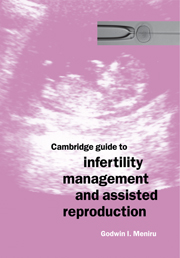Book contents
- Frontmatter
- Contents
- Preface
- Foreword
- Acknowledgements
- Introduction
- 1 The male reproductive system
- 2 The female reproductive system
- 3 Fertilization, implantation and early development
- 4 Male factor problems
- 5 Female factor problems
- 6 Evaluation of the infertile couple
- 7 Medical and surgical treatment of infertility
- 8 Conventional in-vitro fertilization treatment
- 9 Intracytoplasmic sperm injection
- 10 Surgical sperm retrieval
- 11 Intratubal replacement of gametes and embryos (GIFT, ZIFT)
- 12 Intrauterine insemination
- 13 Cryopreservation of gametes, ovarian tissue, testicular tissue and embryos; frozen embryo replacement
- 14 Assisted hatching
- 15 Preimplantation diagnosis of genetic disease
- Appendix: Acronyms in assisted reproduction technology
- Index
11 - Intratubal replacement of gametes and embryos (GIFT, ZIFT)
Published online by Cambridge University Press: 11 September 2009
- Frontmatter
- Contents
- Preface
- Foreword
- Acknowledgements
- Introduction
- 1 The male reproductive system
- 2 The female reproductive system
- 3 Fertilization, implantation and early development
- 4 Male factor problems
- 5 Female factor problems
- 6 Evaluation of the infertile couple
- 7 Medical and surgical treatment of infertility
- 8 Conventional in-vitro fertilization treatment
- 9 Intracytoplasmic sperm injection
- 10 Surgical sperm retrieval
- 11 Intratubal replacement of gametes and embryos (GIFT, ZIFT)
- 12 Intrauterine insemination
- 13 Cryopreservation of gametes, ovarian tissue, testicular tissue and embryos; frozen embryo replacement
- 14 Assisted hatching
- 15 Preimplantation diagnosis of genetic disease
- Appendix: Acronyms in assisted reproduction technology
- Index
Summary
Introduction
Contrary to popular belief, the development of infertility treatment options has not been such a radical exercise. There have always been attempts to pattern treatment modalities as closely as possible to the natural situation and reduce interference to a minimum. This is in part due to uncertainty of what the optimal in vitro situation should be and the impact of the intervention on the viability and integrity of the gametes, embryos, pregnancy or resulting progeny. A classic example is male factor infertility, in which several more conservative and less effective treatment options were utilized for several years before the advent of intracytoplasmic sperm injection (ICSI) (see Chapter 9). Conventional in vitro fertilization (IVF) treatment was developed to overcome the sterilizing effect of tubal blockage. Although the merits of the treatment were obvious, it was still felt that some women with non-tubal infertility may benefit from a less radical approach; the retrieved oocytes were mixed with a prepared sperm sample and replaced in the fallopian tubes, thereby allowing fertilization and subsequent events to take place within the natural environment of the body. Another driving force for the development of tubal gamete or embryo replacement techniques was the then lack of confidence of the in vitro culture environment, including the culture medium and the various aspects of laboratory processing of gametes and embryos.
- Type
- Chapter
- Information
- Publisher: Cambridge University PressPrint publication year: 2001



